Applications and Trends of Machine Learning in Building Energy Optimization: A Bibliometric Analysis
Abstract
1. Introduction
1.1. Background of Machine Learning Applications in Building Energy Efficiency
1.2. Research Status and Problems
- Collaborative networks across regions and institutions have not yet achieved large-scale effectiveness, and research resources and outcomes remain unevenly distributed [22].
1.3. Research Objectives and Significance
- To explore the pivotal role of machine learning in building performance prediction, energy management optimization, and sustainable design.
- To examine the applications and emerging trends of technologies, including deep learning, reinforcement learning, and unsupervised learning, within intelligent building systems.
- To identify current research hotspots and technical challenges, providing actionable recommendations for future research directions and practical applications.
1.4. Structure of This Paper
2. Literature Collection and Analysis Methods
2.1. Research Questions and Scope
- What is the current state of research regarding the application of machine learning in building energy efficiency and carbon reduction?
- How can machine learning technologies be effectively integrated into building systems, and how can specific technical frameworks optimize building energy efficiency and carbon emission management?
- What are the challenges in integrating machine learning methods into building energy systems?
- What are the emerging trends and potential future research directions in this field?
- What are the key factors for optimizing building energy efficiency through machine learning models?
- What specific obstacles exist in the widespread deployment of multi-objective optimization algorithms in real-world building energy systems? How can these obstacles be overcome?
- How can demand-side management in buildings reduce energy consumption through the use of machine learning?
2.2. Data Collection and Selection Criteria
- This study focuses on buildings and their related systems.
- This research explores the application of machine learning technologies—particularly deep learning, reinforcement learning, and unsupervised learning—in building energy efficiency optimization, energy management, or carbon emission control.
- The information is published in peer-reviewed scientific articles or conference papers.
2.3. Bibliometric Analysis Tools and Methods
3. Results
3.1. Demographic Overview of the Study Area
3.1.1. Overview of the Sampled Publications
3.1.2. Authors with the Highest Productivity
3.1.3. The Most Influential Sources
3.1.4. Leading Publications in the Field
3.1.5. Three-Field Plot Overview
3.2. Geographical Perspective of the Study Area
3.2.1. Scientific Output and Collaboration Across Countries
3.2.2. Countries’ Key Research Affiliations
3.3. Intellectual Perspective of the Study Area
3.3.1. Author Co-Citation Analysis
3.3.2. Journal Co-Citation Analysis
3.3.3. Document Co-Citation Analysis
3.3.4. Co-Occurring Keyword Network
3.4. Thematic Evolution Perspective of the Study Area
3.4.1. Thematic Map
- Basic themes are located in the lower-right quadrant, which contains underdeveloped but general topics [72];
- Motor themes are situated in the upper-right quadrant, encompassing highly developed and central themes crucial to the field [72];
- Niche themes occupy the upper-left quadrant, representing specialized yet peripheral topics with strong internal connections, even if their overall importance is not as high [72];
- Emerging or declining themes are located in the lower-left quadrant, representing those with low density and centrality, which could potentially develop into more prominent topics in the future [72].
3.4.2. Clustering by Coupling
3.5. Application Perspective of the Study Area
3.5.1. Practical Applications of Machine Learning in Various Scenarios
3.5.2. Application Challenges and Technical Bottlenecks
3.5.3. Opportunities and Transformations with Emerging Technologies
4. Discussion
5. Conclusions
- Strengthening interdisciplinary collaboration: Future work should promote deep collaboration across architecture, engineering, computer science, and energy science to develop customized machine learning models that address the challenges of different building types and climates. While the existing literature addresses the integration of machine learning with building systems, research on interdisciplinary integration is still scarce.
- Expanding data sharing and benchmarking: To overcome data quality and model generalization issues, it is crucial to develop large open-source datasets and encourage sharing within the academic community. Establishing standardized building energy optimization benchmark datasets will facilitate more consistent and comparable research outcomes.
- Improving model transparency and interpretability: Research should advance hybrid models that combine physics-based models with data-driven machine learning approaches, ensuring that machine learning systems in building energy management are transparent and interpretable, thus enhancing stakeholders’ trust in the decision-making process.
- Developing cost-effective deployment strategies: Future research should focus on reducing the deployment costs of building machine learning systems and exploring technologies such as cloud computing, edge computing, and federated learning to reduce the need for large-scale data collection and centralized processing. Edge computing, though still in its early stages in building energy efficiency optimization, holds significant potential for improving real-time data processing and energy efficiency control.
- Integrating smart IoT and energy systems: Future research should focus on the deep integration of smart IoT devices with building energy management systems, exploring the potential for IoT and machine learning to work synergistically for real-time energy optimization and carbon emission control, especially in the context of rapidly developing smart city infrastructure.
- Addressing building lifecycle and sustainability issues: Research should cover the entire building lifecycle, with an emphasis on exploring how machine learning can promote sustainability across all stages, specifically, how machine learning can optimize material selection, reduce waste, and enhance a building’s ability to adapt to climate change.
Author Contributions
Funding
Data Availability Statement
Acknowledgments
Conflicts of Interest
References
- Aversa, P.; Donatelli, A.; Piccoli, G.; Luprano, V.A.M. Improved Thermal Transmittance Measurement with HFM Technique on Building Envelopes in the Mediterranean Area. Sel. Sci. Pap.—J. Civ. Eng. 2016, 11, 39–52. [Google Scholar] [CrossRef]
- Shaamala, A.; Yigitcanlar, T.; Nili, A.; Nyandega, D. Algorithmic Green Infrastructure Optimisation: Review of Artificial Intelligence Driven Approaches for Tackling Climate Change. Sustain. Cities Soc. 2024, 101, 105182. [Google Scholar] [CrossRef]
- Zhou, Y.; Zheng, S. A Co-Simulated Material-Component-System-District Framework for Climate-Adaption and Sustainability Transition. Renew. Sustain. Energy Rev. 2024, 192, 114184. [Google Scholar] [CrossRef]
- Abdelrahman, M.; Zhan, S.; Miller, C.; Chong, A. Data Science for Building Energy Efficiency: A Comprehensive Text-Mining Driven Review of Scientific Literature. Energy Build. 2021, 242, 110885. [Google Scholar] [CrossRef]
- Hong, T.; Wang, Z.; Luo, X.; Zhang, W. State-of-the-Art on Research and Applications of Machine Learning in the Building Life Cycle. Energy Build. 2020, 212, 109831. [Google Scholar] [CrossRef]
- Li, Y.; Chen, H.; Yu, P.; Yang, L. The Application and Evaluation of the LMDI Method in Building Carbon Emissions Analysis: A Comprehensive Review. Buildings 2024, 14, 2820. [Google Scholar] [CrossRef]
- Li, Z.; Ma, J.; Tan, Y.; Guo, C.; Li, X. Combining Physical Approaches with Deep Learning Techniques for Urban Building Energy Modeling: A Comprehensive Review and Future Research Prospects. Build. Environ. 2023, 246, 110960. [Google Scholar] [CrossRef]
- Asghari, V.; Wang, Y.; Biglari, A.; Hsu, S.; Tang, P. Reinforcement Learning in Construction Engineering and Management: A Review. J. Constr. Eng. Manag. 2022, 148, 03122009. [Google Scholar] [CrossRef]
- Fu, Q.; Han, Z.; Chen, J.; Lu, Y.; Wu, H.; Wang, Y. Applications of Reinforcement Learning for Building Energy Efficiency Control: A Review. J. Build. Eng. 2022, 50, 104165. [Google Scholar] [CrossRef]
- Weinberg, D.; Wang, Q.; Timoudas, T.; Fischione, C. A Review of Reinforcement Learning for Controlling Building Energy Systems From a Computer Science Perspective. Sustain. Cities Soc. 2023, 89, 104351. [Google Scholar] [CrossRef]
- Yu, H.; Tam, V.; Xu, X. A Systematic Review of Reinforcement Learning Application in Building Energy-Related Occupant Behavior Simulation. Energy Build. 2024, 312, 114189. [Google Scholar] [CrossRef]
- Hasan, Z.; Roy, N. Trending Machine Learning Models in Cyber-Physical Building Environment: A Survey. Wiley Interdiscip. Rev.-Data Min. Knowl. Discov. 2021, 11, e1422. [Google Scholar] [CrossRef]
- Um-e-Habiba; Ahmed, I.; Asif, M.; Alhelou, H.; Khalid, M. A Review on Enhancing Energy Efficiency and Adaptability through System Integration for Smart Buildings. J. Build. Eng. 2024, 89, 109354. [Google Scholar] [CrossRef]
- Ghahramani, A.; Galicia, P.; Lehrer, D.; Varghese, Z.; Wang, Z.; Pandit, Y. Artificial Intelligence for Efficient Thermal Comfort Systems: Requirements, Current Applications and Future Directions. Front. Built Environ. 2020, 6, 49. [Google Scholar] [CrossRef]
- Balali, Y.; Chong, A.; Busch, A.; O’Keefe, S. Energy Modelling and Control of Building Heating and Cooling Systems with Data-Driven and Hybrid Models—A Review. Renew. Sustain. Energy Rev. 2023, 183, 113496. [Google Scholar] [CrossRef]
- Elwy, I.; Hagishima, A. The Artificial Intelligence Reformation of Sustainable Building Design Approach: A Systematic Review on Building Design Optimization Methods Using Surrogate Models. Energy Build. 2024, 323, 114769. [Google Scholar] [CrossRef]
- Zhou, Y.; Liu, J. Advances in Emerging Digital Technologies for Energy Efficiency and Energy Integration in Smart Cities. Energy Build. 2024, 315, 114289. [Google Scholar] [CrossRef]
- Abdel-Jaber, F.; Dirks, K. A Review of Cooling and Heating Loads Predictions of Residential Buildings Using Data-Driven Techniques. Buildings 2024, 14, 752. [Google Scholar] [CrossRef]
- Ayoub, M. A Review on Machine Learning Algorithms to Predict Daylighting inside Buildings. Sol. Energy 2020, 202, 249–275. [Google Scholar] [CrossRef]
- Zhang, W.; Wu, Y.; Calautit, J. A Review on Occupancy Prediction through Machine Learning for Enhancing Energy Efficiency, Air Quality and Thermal Comfort in the Built Environment. Renew. Sustain. Energy Rev. 2022, 167, 112704. [Google Scholar] [CrossRef]
- Michailidis, P.; Michailidis, I.; Vamvakas, D.; Kosmatopoulos, E. Model-Free HVAC Control in Buildings: A Review. Energies 2023, 16, 7124. [Google Scholar] [CrossRef]
- Vosoughkhosravi, S.; Jafari, A. Creating a Large-Scale National Residential Building Energy Dataset Using a Two-Stage Machine Learning Approach; Shane, J., Madson, K., Mo, Y., Poleacovschi, C., Sturgill, R., Eds.; ASCM: Reston, VA, USA, 2024; pp. 305–315. [Google Scholar]
- Asif, M.; Naeem, G.; Khalid, M. Digitalization for Sustainable Buildings: Technologies, Applications, Potential, and Challenges. J. Clean. Prod. 2024, 450, 141814. [Google Scholar] [CrossRef]
- Suphavarophas, P.; Wongmahasiri, R.; Keonil, N.; Bunyarittikit, S. A Systematic Review of Applications of Generative Design Methods for Energy Efficiency in Buildings. Buildings 2024, 14, 1311. [Google Scholar] [CrossRef]
- Adhikari, R.; Gautam, Y.; Jebelli, H.; Sitzabee, W. Deep Learning and Reinforcement Learning for Modeling Occupants’ Information in an Occupant-Centric Building Control: A Systematic Literature Review. In Construction Research Congress 2024; Shane, J., Madson, K., Mo, Y., Poleacovschi, C., Sturgill, R., Eds.; ASCM: Reston, VA, USA, 2024; pp. 186–195. [Google Scholar]
- Manfren, M.; Gonzalez-Carreon, K.; James, P. Interpretable Data-Driven Methods for Building Energy Modelling-A Review of Critical Connections and Gaps. Energies 2024, 17, 881. [Google Scholar] [CrossRef]
- Olu-Ajayi, R.; Alaka, H.; Sunmola, F.; Ajayi, S.; Mporas, I. Statistical and Artificial Intelligence-Based Tools for Building Energy Prediction: A Systematic Literature Review. IEEE Trans. Eng. Manag. 2024, 71, 14733–14753. [Google Scholar] [CrossRef]
- Sun, K.; Zhao, Q.; Zou, J. A Review of Building Occupancy Measurement Systems. Energy Build. 2020, 216, 109965. [Google Scholar] [CrossRef]
- Wang, M.; Jia, Z.; Tao, L.; Xiang, C. Review of Dynamic Façade Typologies, Physical Performance and Control Methods: Towards Smarter and Cleaner Zero-Energy Buildings. J. Build. Eng. 2024, 98, 111310. [Google Scholar] [CrossRef]
- Mondal, N.; Anand, P.; Khan, A.; Deb, C.; Cheong, D.; Sekhar, C.; Niyogi, D.; Santamouris, M. Systematic Review of the Efficacy of Data-Driven Urban Building Energy Models during Extreme Heat in Cities: Current Trends and Future Outlook. Build. Simul. 2024, 17, 695–722. [Google Scholar] [CrossRef]
- Fu, H.; Baltazar, J.; Claridge, D. Review of Developments in Whole-Building Statistical Energy Consumption Models for Commercial Buildings. Renew. Sustain. Energy Rev. 2021, 147, 111248. [Google Scholar] [CrossRef]
- Zhu, X.; Zhang, X.; Gong, P.; Li, Y. A review of distributed energy system optimization for building decarbonization. J. Build. Eng. 2023, 73, 106735. [Google Scholar] [CrossRef]
- Bellagarda, A.; Cesari, S.; Aliberti, A.; Ugliotti, F.; Bottaccioli, L.; Macii, E.; Patti, E. Effectiveness of Neural Networks and Transfer Learning for Indoor Air-Temperature Forecasting. Autom. Constr. 2022, 140, 104314. [Google Scholar] [CrossRef]
- Grant, M.J.; Booth, A. A Typology of Reviews: An Analysis of 14 Review Types and Associated Methodologies. Health Inf. Libr. J. 2009, 26, 91–108. [Google Scholar] [CrossRef]
- Lempel, R.; Moran, S. SALSA: The Stochastic Approach for Link-Structure Analysis. ACM Trans. Inf. Syst. 2001, 19, 131–160. [Google Scholar] [CrossRef]
- Systematic Approaches to a Successful Literature Review; SAGE Publications Ltd.: Thousand Oaks, CA, USA; Available online: https://uk.sagepub.com/en-gb/eur/systematic-approaches-to-a-successful-literature-review/book270933 (accessed on 13 January 2025).
- Harzing, A.-W.; Alakangas, S. Google Scholar, Scopus and the Web of Science: A Longitudinal and Cross-Disciplinary Comparison. Scientometrics 2016, 106, 787–804. [Google Scholar] [CrossRef]
- Liu, W. Caveats for the Use of Web of Science Core Collection in Old Literature Retrieval and Historical Bibliometric Analysis. Technol. Forecast. Soc. Chang. 2021, 172, 121023. [Google Scholar] [CrossRef]
- Moral-Muñoz, J.A.; Herrera-Viedma, E.; Santisteban-Espejo, A.; Cobo, M.J. Software Tools for Conducting Bibliometric Analysis in Science: An up-to-Date Review. Prof. Inf. 2020, 29, e290103. [Google Scholar] [CrossRef]
- Leydesdorff, L.; Carley, S.; Rafols, I. Global Maps of Science Based on the New Web-of-Science Categories. Scientometrics 2013, 94, 589–593. [Google Scholar] [CrossRef]
- Velez-Estevez, A.; García-Sánchez, P.; Moral-Munoz, J.A.; Cobo, M.J. Why Do Papers from International Collaborations Get More Citations? A Bibliometric Analysis of Library and Information Science Papers. Scientometrics 2022, 127, 7517–7555. [Google Scholar] [CrossRef]
- Ibáñez, A.; Bielza, C.; Larrañaga, P. Relationship among Research Collaboration, Number of Documents and Number of Citations: A Case Study in Spanish Computer Science Production in 2000–2009. Scientometrics 2013, 95, 689–716. [Google Scholar] [CrossRef]
- Nicholls, P.T. Bibliometric Modeling Processes and the Empirical Validity of Lotka’s Law. J. Am. Soc. Inf. Sci. 1989, 40, 379–385. [Google Scholar] [CrossRef]
- Newby, G.B.; Greenberg, J.; Jones, P. Open Source Software Development and Lotka’s Law: Bibliometric Patterns in Programming. J. Am. Soc. Inf. Sci. Technol. 2003, 54, 169–178. [Google Scholar] [CrossRef]
- Patra, S.K.; Bhattacharya, P.; Verma, N. Bibliometric Study of Literature on Bibliometrics. DESIDOC J. Libr. Inf. Technol. 2006, 26, 27–32. [Google Scholar] [CrossRef]
- Alabi, G. Bradford’s Law and Its Application. Int. Libr. Rev. 1979, 11, 151–158. [Google Scholar] [CrossRef]
- Nash-Stewart, C.E.; Kruesi, L.M.; Del Mar, C.B. Does Bradford’s Law of Scattering Predict the Size of the Literature in Cochrane Reviews? J. Med. Libr. Assoc. 2012, 100, 135–138. [Google Scholar] [CrossRef]
- Olu-Ajayi, R.; Alaka, H.; Sulaimon, I.; Sunmola, F.; Ajayi, S. Building Energy Consumption Prediction for Residential Buildings Using Deep Learning and Other Machine Learning Techniques. J. Build. Eng. 2022, 45, 103406. [Google Scholar] [CrossRef]
- Brandi, S.; Piscitelli, M.; Martellacci, M.; Capozzoli, A. Deep Reinforcement Learning to Optimise Indoor Temperature Control and Heating Energy Consumption in Buildings. Energy Build. 2020, 224, 110225. [Google Scholar] [CrossRef]
- Xie, J.; Li, H.; Li, C.; Zhang, J.; Luo, M. Review on Occupant-Centric Thermal Comfort Sensing, Predicting, and Controlling. Energy Build. 2020, 226, 110392. [Google Scholar] [CrossRef]
- Gopinath, R.; Kumar, M.; Prakash Chandra Joshua, C.; Srinivas, K. Energy Management Using Non-Intrusive Load Monitoring Techniques—State-of-the-Art and Future Research Directions. Sustain. Cities Soc. 2020, 62, 102411. [Google Scholar] [CrossRef]
- Dong, Z.; Liu, J.; Liu, B.; Li, K.; Li, X. Hourly Energy Consumption Prediction of an Office Building Based on Ensemble Learning and Energy Consumption Pattern Classification. Energy Build. 2021, 241, 110929. [Google Scholar] [CrossRef]
- Hosamo, H.; Svennevig, P.; Svidt, K.; Han, D.; Nielsen, H. A Digital Twin Predictive Maintenance Framework of Air Handling Units Based on Automatic Fault Detection and Diagnostics. Energy Build. 2022, 261, 111988. [Google Scholar] [CrossRef]
- Seyedzadeh, S.; Rahimian, F.; Oliver, S.; Rodriguez, S.; Glesk, I. Machine Learning Modelling for Predicting Non-Domestic Buildings Energy Performance: A Model to Support Deep Energy Retrofit Decision-Making. Appl. Energy 2020, 279, 115908. [Google Scholar] [CrossRef]
- Mounir, N.; Ouadi, H.; Jrhilifa, I. Short-Term Electric Load Forecasting Using an EMD-BI-LSTM Approach for Smart Grid Energy Management System. Energy Build. 2023, 288, 113022. [Google Scholar] [CrossRef]
- Börner, K.; Chen, C.; Boyack, K.W. Visualizing Knowledge Domains. Annu. Rev. Inf. Sci. Technol. 2003, 37, 179–255. [Google Scholar] [CrossRef]
- Han, Z.; Peng, K.; Mi, J.; Li, B. The Smart City: A New Solution to Urban Shrinkage? Evidence from China. J. Asian Public Policy 2024, 17, 160–179. [Google Scholar] [CrossRef]
- Yu, C.; Yu, J.; Gao, D. Smart Cities and Greener Futures: Evidence from a Quasi-Natural Experiment in China’s Smart City Construction. Sustainability 2024, 16, 929. [Google Scholar] [CrossRef]
- Bijlani, V. Smart Buildings for Sustainable Smart Cities. In Proceedings of the 2023 1st International Conference on Advanced Innovations in Smart Cities (ICAISC), Jeddah, Saudi Arabia, 23–25 January 2023; pp. 1–6. [Google Scholar]
- Gedikli, A.; Taş, C.Y.; Taş, N.B. Redefining Smart Cities, Urban Energy, and Green Technologies for Sustainable Development. In Handbook of Research on Sustainable Development Goals, Climate Change, and Digitalization; IGI Global Scientific Publishing: Hershey, PA, USA, 2022; pp. 216–232. ISBN 978-1-7998-8482-8. [Google Scholar]
- Qiu, J.-P.; Dong, K.; Yu, H.-Q. Comparative Study on Structure and Correlation among Author Co-Occurrence Networks in Bibliometrics. Scientometrics 2014, 101, 1345–1360. [Google Scholar] [CrossRef]
- Amasyali, K.; El-Gohary, N.M. A Review of Data-Driven Building Energy Consumption Prediction Studies. Renew. Sustain. Energy Rev. 2018, 81, 1192–1205. [Google Scholar] [CrossRef]
- Pérez-Lombard, L.; Ortiz, J.; Pout, C. A Review on Buildings Energy Consumption Information. Energy Build. 2008, 40, 394–398. [Google Scholar] [CrossRef]
- Sutton, R.S.; Barto, A.G. Reinforcement Learning: An Introduction, 2nd ed.; The MIT Press: Cambridge, MA, USA, 2018; pp. xxii, 526. ISBN 978-0-262-03924-6. [Google Scholar]
- Mnih, V.; Kavukcuoglu, K.; Silver, D.; Rusu, A.A.; Veness, J.; Bellemare, M.G.; Graves, A.; Riedmiller, M.; Fidjeland, A.K.; Ostrovski, G.; et al. Human-Level Control through Deep Reinforcement Learning. Nature 2015, 518, 529–533. [Google Scholar] [CrossRef]
- Breiman, L. Random Forests. Mach. Learn. 2001, 45, 5–32. [Google Scholar] [CrossRef]
- Small, H. Co-Citation in the Scientific Literature: A New Measure of the Relationship between Two Documents. J. Am. Soc. Inf. Sci. 1973, 24, 265–269. [Google Scholar] [CrossRef]
- Griffith, B.C.; Small, H.G.; Stonehill, J.A.; Dey, S. The Structure of Scientific Literatures II: Toward a Macro- and Microstructure for Science. Sci. Stud. 1974, 4, 339–365. [Google Scholar] [CrossRef]
- Bui, D.; Nguyen, T.; Ngo, T.; Nguyen-Xuan, H. An Artificial Neural Network (ANN) Expert System Enhanced with the Electromagnetism-Based Firefly Algorithm (EFA) for Predicting the Energy Consumption in Buildings. Energy 2020, 190, 116370. [Google Scholar] [CrossRef]
- Aria, M.; Cuccurullo, C.; D’Aniello, L.; Misuraca, M.; Spano, M. Thematic Analysis as a New Culturomic Tool: The Social Media Coverage on COVID-19 Pandemic in Italy. Sustainability 2022, 14, 3643. [Google Scholar] [CrossRef]
- Wilczewski, M.; Alon, I. Language and Communication in International Students’ Adaptation: A Bibliometric and Content Analysis Review. Hig. Edu. 2023, 85, 1235–1256. [Google Scholar] [CrossRef]
- Herrera, J.; De Las Heras-Rosas, C. The Organizational Commitment in the Company and Its Relationship With the Psychological Contract. Front. Psychol. 2021, 11, 3978. [Google Scholar] [CrossRef]
- Salton, G.; McGill, M.J. Introduction to Modern Information Retrieval; McGraw-Hill, Inc.: New York, NY, USA, 1986; ISBN 978-0-07-054484-0. [Google Scholar]
- Smeaton, A.F. Using NLP or NLP Resources for Information Retrieval Tasks. In Natural Language Information Retrieval; Strzalkowski, T., Ed.; Springer Netherlands: Dordrecht, The Netherlands, 1999; pp. 99–111. ISBN 978-94-017-2388-6. [Google Scholar]
- Han, Y.; Li, J.; Lou, X.; Fan, C.; Geng, Z. Energy Saving of Buildings for Reducing Carbon Dioxide Emissions Using Novel Dendrite Net Integrated Adaptive Mean Square Gradient. Appl. Energy 2022, 309, 118409. [Google Scholar] [CrossRef]
- Li, G.; Wu, Y.; Liu, J.; Fang, X.; Wang, Z. Performance Evaluation of Short-Term Cross-Building Energy Predictions Using Deep Transfer Learning Strategies. Energy Build. 2022, 275, 112461. [Google Scholar] [CrossRef]
- Pan, Y.; Zhang, L. Data-Driven Estimation of Building Energy Consumption with Multi-Source Heterogeneous Data. Appl. Energy 2020, 268, 114965. [Google Scholar] [CrossRef]
- Verma, A.; Prakash, S.; Kumar, A. ANN-Based Energy Consumption Prediction Model up to 2050 for a Residential Building: Towards Sustainable Decision Making. Environ. Prog. Sustain. Energy 2021, 40, e13544. [Google Scholar] [CrossRef]
- Piras, G.; Muzi, F.; Ziran, Z. Open Tool for Automated Development of Renewable Energy Communities: Artificial Intelligence and Machine Learning Techniques for Methodological Approach. Energies 2024, 17, 5726. [Google Scholar] [CrossRef]
- Venkatraj, V.; Dixit, M.; Yan, W.; Caffey, S.; Sideris, P.; Aryal, A. Toward the Application of a Machine Learning Framework for Building Life Cycle Energy Assessment. Energy Build. 2023, 297, 113444. [Google Scholar] [CrossRef]
- Zhang, X.; Chen, H.; Sun, J.; Zhang, X. Predictive Models of Embodied Carbon Emissions in Building Design Phases: Machine Learning Approaches Based on Residential Buildings in China. Build. Environ. 2024, 258, 111595. [Google Scholar] [CrossRef]
- Zheng, L.; Mueller, M.; Luo, C.; Yan, X. Predicting Whole-Life Carbon Emissions for Buildings Using Different Machine Learning Algorithms: A Case Study on Typical Residential Properties in Cornwall, UK. Appl. Energy 2024, 357, 122472. [Google Scholar] [CrossRef]
- Li, Z.; Zhao, Y.; Xia, H.; Xie, S. A Multi-Objective Optimization Framework for Building Performance under Climate Change. J. Build. Eng. 2023, 80, 107978. [Google Scholar] [CrossRef]
- Zhang, C.; Tian, X.; Zhao, Y.; Lu, J. Automated Machine Learning-Based Building Energy Load Prediction Method. J. Build. Eng. 2023, 80, 108071. [Google Scholar] [CrossRef]
- Zhang, H.; Feng, H.; Hewage, K.; Arashpour, M. Artificial Neural Network for Predicting Building Energy Performance: A Surrogate Energy Retrofits Decision Support Framework. Buildings 2022, 12, 829. [Google Scholar] [CrossRef]
- Abdou, N.; El Mghouchi, Y.; Jraida, K.; Hamdaoui, S.; Hajou, A.; Mouqallid, M. Prediction and Optimization of Heating and Cooling Loads for Low Energy Buildings in Morocco: An Application of Hybrid Machine Learning Methods. J. Build. Eng. 2022, 61, 105332. [Google Scholar] [CrossRef]
- Biloria, N.; Makki, M.; Abdollahzadeh, N. Multi-Performative Façade Systems: The Case of Real-Time Adaptive BIPV Shading Systems to Enhance Energy Generation Potential and Visual Comfort. Front. Built Environ. 2023, 9, 1119696. [Google Scholar] [CrossRef]
- Pan, H.; Wu, C. Bayesian Optimization + XGBoost Based Life Cycle Carbon Emission Prediction for Residential Buildings—An Example from Chengdu, China. Build. Simul. 2023, 16, 1451–1466. [Google Scholar] [CrossRef]
- Salami, B.; Abba, S.; Adewumi, A.; Dodo, U.; Otukogbe, G.; Oyedele, L. Building Energy Loads Prediction Using Bayesian-Based Metaheuristic Optimized-Explainable Tree-Based Model. Case Stud. Constr. Mater. 2023, 19, e02676. [Google Scholar] [CrossRef]
- Wang, H.; Wen, W.; Zhang, Z.; Gao, N. Construction of Building Energy Consumption Prediction Model Based on Multi-Optimization Model. Buildings 2023, 13, 1677. [Google Scholar] [CrossRef]
- Bhamare, D.; Saikia, P.; Rathod, M.; Rakshit, D.; Banerjee, J. A Machine Learning and Deep Learning Based Approach to Predict the Thermal Performance of Phase Change Material Integrated Building Envelope. Build. Environ. 2021, 199, 107927. [Google Scholar] [CrossRef]
- Ly, H.-B.; Nguyen, M.H.; Pham, B.T. Metaheuristic Optimization of Levenberg–Marquardt-Based Artificial Neural Network Using Particle Swarm Optimization for Prediction of Foamed Concrete Compressive Strength. Neural Compu. Appl. 2021, 33, 17331–17351. [Google Scholar] [CrossRef]
- Rezaie, M.; Kariminia, S.; Band, S.; Ameri, R.; Farokhi, M.; Pai, H.; Gocer, O.; Rismanchi, B.; Shooshtarian, S. Energy Consumption of High-Rise Double Skin Façade Buildings, a Machine Learning Analysis. J. Build. Eng. 2024, 89, 109230. [Google Scholar] [CrossRef]
- Dai, X.; Cheng, S.; Chong, A. Deciphering Optimal Mixed-Mode Ventilation in the Tropics Using Reinforcement Learning with Explainable Artificial Intelligence. Energy Build. 2023, 278, 112629. [Google Scholar] [CrossRef]
- Norouzi, P.; Maalej, S.; Mora, R. Applicability of Deep Learning Algorithms for Predicting Indoor Temperatures: Towards the Development of Digital Twin HVAC Systems. Buildings 2023, 13, 1542. [Google Scholar] [CrossRef]
- Hosamo, H.; Nielsen, H.; Kraniotis, D.; Svennevig, P.; Svidt, K. Improving Building Occupant Comfort through a Digital Twin Approach: A Bayesian Network Model and Predictive Maintenance Method. Energy Build. 2023, 288, 112992. [Google Scholar]
- Deng, J.; Eklund, M.; Sierla, S.; Savolainen, J.; Niemistö, H.; Karhela, T.; Vyatkin, V. Deep Reinforcement Learning for Fuel Cost Optimization in District Heating. Sustain. Cities Soc. 2023, 99, 104955. [Google Scholar] [CrossRef]
- Fang, Z.; Crimier, N.; Scanu, L.; Midelet, A.; Alyafi, A.; Delinchant, B. Multi-Zone Indoor Temperature Prediction with LSTM-Based Sequence to Sequence Model☆. Energy Build. 2021, 245, 111053. [Google Scholar] [CrossRef]
- Chen, R.; Tsay, Y. Carbon Emission and Thermal Comfort Prediction Model for an Office Building Considering the Contribution Rate of Design Parameters. Energy Rep. 2022, 8, 8093–8107. [Google Scholar] [CrossRef]
- Jia, T.; He, W.; Ma, W. Optimizing Urban Energy Management: A Strategic Examination of Smart Grids and Policy Regulations. Sustain. Cities Soc. 2024, 106, 105379. [Google Scholar] [CrossRef]
- Hong, G.; Choi, G.; Eum, J.; Lee, H.; Kim, D. The Hourly Energy Consumption Prediction by KNN for Buildings in Community Buildings. Buildings 2022, 12, 1636. [Google Scholar] [CrossRef]
- Blad, C.; Bogh, S.; Kallesoe, C. Data-Driven Offline Reinforcement Learning for HVAC-Systems. Energy 2022, 261, 125290. [Google Scholar] [CrossRef]
- Lin, X.; Guo, Q.; Yuan, D.; Gao, M. Bayesian Optimization Framework for HVAC System Control. Buildings 2023, 13, 314. [Google Scholar] [CrossRef]
- Li, W.; Zhao, Y.; Zhang, J.; Jiang, C.; Chen, S.; Lin, L.; Wang, Y. Indoor Temperature Preference Setting Control Method for Thermal Comfort and Energy Saving Based on Reinforcement Learning. J. Build. Eng. 2023, 73, 106805. [Google Scholar] [CrossRef]
- Chiosa, R.; Piscitelli, M.; Fan, C.; Capozzoli, A. Towards a Self-Tuned Data Analytics-Based Process for an Automatic Context-Aware Detection and Diagnosis of Anomalies in Building Energy Consumption Timeseries. Energy Build. 2022, 270, 112302. [Google Scholar] [CrossRef]
- Zhao, Y.; Yang, Z.; Zhu, J.; Hou, Z.; Zhang, S.; Hu, Y.; Shu, Y. Research on the Dynamic Characterization and Detection of Refrigerant Leakage in Multi-Connected Air-Conditioning System. Energy Build. 2024, 309, 114076. [Google Scholar] [CrossRef]
- Liu, Z.; Zhang, X.; Sun, Y.; Zhou, Y. Advanced Controls on Energy Reliability, Flexibility and Occupant-Centric Control for Smart and Energy-Efficient Buildings. Energy Build. 2023, 297, 113436. [Google Scholar] [CrossRef]
- Chen, S.; Ding, P.; Zhou, G.; Zhou, X.; Li, J.; Wang, L.; Wu, H.; Fan, C.; Li, J. A Novel Machine Learning-Based Model Predictive Control Framework for Improving the Energy Efficiency of Air-Conditioning Systems. Energy Build. 2023, 294, 113258. [Google Scholar] [CrossRef]
- Erisen, S. A Systematic Approach to Optimizing Energy-Efficient Automated Systems with Learning Models for Thermal Comfort Control in Indoor Spaces. Buildings 2023, 13, 1824. [Google Scholar] [CrossRef]
- Ding, Z.; Fu, Q.; Chen, J.; Lu, Y.; Wu, H.; Fang, N.; Xing, B. MAQMC: Multi-Agent Deep Q-Network for Multi-Zone Residential HVAC Control. Comput. Model. Eng. Sci. 2023, 136, 2759–2785. [Google Scholar] [CrossRef]
- Omidvar, A.; Kim, J. A Novel Theoretical Model for Predicting the Individuals’ Thermal Sensations Based on Air Temperature and Biomarkers Measured by Wearable Devices. Build. Environ. 2023, 232, 110050. [Google Scholar] [CrossRef]
- Deng, Q.; Chen, Z.; Zhu, W.; Li, Z.; Yuan, Y.; Wang, Y. Adaptive Fusion Graph Convolutional Network Based Interpretable Fault Diagnosis Method for HVAC Systems Enhanced by Unlabeled Data. Energy Build. 2024, 324, 114901. [Google Scholar] [CrossRef]
- Ren, H.; Xu, C.; Lyu, Y.; Ma, Z.; Sun, Y. A Thermodynamic-Law-Integrated Deep Learning Method for High-Dimensional Sensor Fault Detection in Diverse Complex HVAC Systems. Appl. Energy 2023, 351, 121830. [Google Scholar] [CrossRef]
- Faridah, F.; Utami, S.; Wijaya, D.; Yanti, R.; Putra, W.; Adrian, B. An Indoor Airflow Distribution Predictor Using Machine Learning for a Real-Time Healthy Building Monitoring System in the Tropics. Build. Serv. Eng. Res. Technol. 2024, 45, 293–315. [Google Scholar] [CrossRef]
- Liao, J.; Yang, D.; Arshad, N.; Venkatachalam, K.; Ahmadian, A. MEMS: An Automated Multi-Energy Management System for Smart Residences Using the DD-LSTM Approach. Sustain. Cities Soc. 2023, 98, 104850. [Google Scholar] [CrossRef]
- Quevedo, T.; Geraldi, M.; Melo, A. Applying Machine Learning to Develop Energy Benchmarking for University Buildings in Brazil. J. Build. Eng. 2023, 63, 105468. [Google Scholar] [CrossRef]
- Li, J.; Zhang, C.; Zhao, Y.; Qiu, W.; Chen, Q.; Zhang, X. Federated Learning-Based Short-Term Building Energy Consumption Prediction Method for Solving the Data Silos Problem. Build. Simul. 2022, 15, 1145–1159. [Google Scholar] [CrossRef]
- Dridi, J.; Amayri, M.; Bouguila, N. Unsupervised Domain Adaptation with and without Access to Source Data for Estimating Occupancy and Recognizing Activities in Smart Buildings. Build. Environ. 2023, 243, 110651. [Google Scholar] [CrossRef]
- Papachatzis, K. Machine Learning-Based Price Prediction for Thermal Insulation Materials: A Holistic Approach Integrating Thermophysical, Technical, and Environmental Attributes in the Greek Construction Market. Energy Build. 2024, 324, 114899. [Google Scholar]
- Cui, H.; Zhang, L.; Yang, H.; Shi, Y. Optimizing Thermal Comfort and Energy Efficiency in Hospitals with PCM-Enhanced Wall Systems. Energy Build. 2024, 323, 114740. [Google Scholar] [CrossRef]
- Jun, H.; Fei, H. Research on Multi-Objective Optimization of Building Energy Efficiency Based on Energy Consumption and Thermal Comfort. Build. Serv. Eng. Res. Technol. 2024, 45, 391–411. [Google Scholar] [CrossRef]
- Shen, Y.; Pan, Y. BIM-Supported Automatic Energy Performance Analysis for Green Building Design Using Explainable Machine Learning and Multi-Objective Optimization. Appl. Energy 2023, 333, 120575. [Google Scholar] [CrossRef]
- Liu, Z.; Zhong, J.; Liu, Y.; Liang, Y.; Li, Z. Dynamic Simulation of Street-Level Carbon Emissions in Megacities: A Case Study of Wuhan City, China (2015–2030). Sustain. Cities Soc. 2024, 115, 105853. [Google Scholar] [CrossRef]
- Mo, Y.; Zhao, D. Effective Factors for Residential Building Energy Modeling Using Feature Engineering. J. Build. Eng. 2021, 44, 102891. [Google Scholar] [CrossRef]
- Zheng, W.; Wang, D.; Wang, Z. Economic Model Predictive Control for Building HVAC System: A Comparative Analysis of Model-Based and Data-Driven Approaches Using the BOPTEST Framework. Appl. Energy 2024, 374, 123969. [Google Scholar] [CrossRef]
- Excell, L.E.; Andrews, A.; Jain, R.K. E-Audit: A “No-Touch” Energy Audit That Integrates Machine Learning and Simulation. Energy Build. 2024, 317, 114360. [Google Scholar] [CrossRef]
- Dridi, J.; Amayri, M.; Bouguila, N. Unsupervised Clustering-Based Domain Adaptation for Estimating Occupancy and Recognizing Activities in Smart Buildings. J. Build. Eng. 2024, 85, 108741. [Google Scholar] [CrossRef]
- Pinto, G.; Messina, R.; Li, H.; Hong, T.; Piscitelli, M.; Capozzoli, A. Sharing Is Caring: An Extensive Analysis of Parameter-Based Transfer Learning for the Prediction of Building Thermal Dynamics. Energy Build. 2022, 276, 112530. [Google Scholar] [CrossRef]
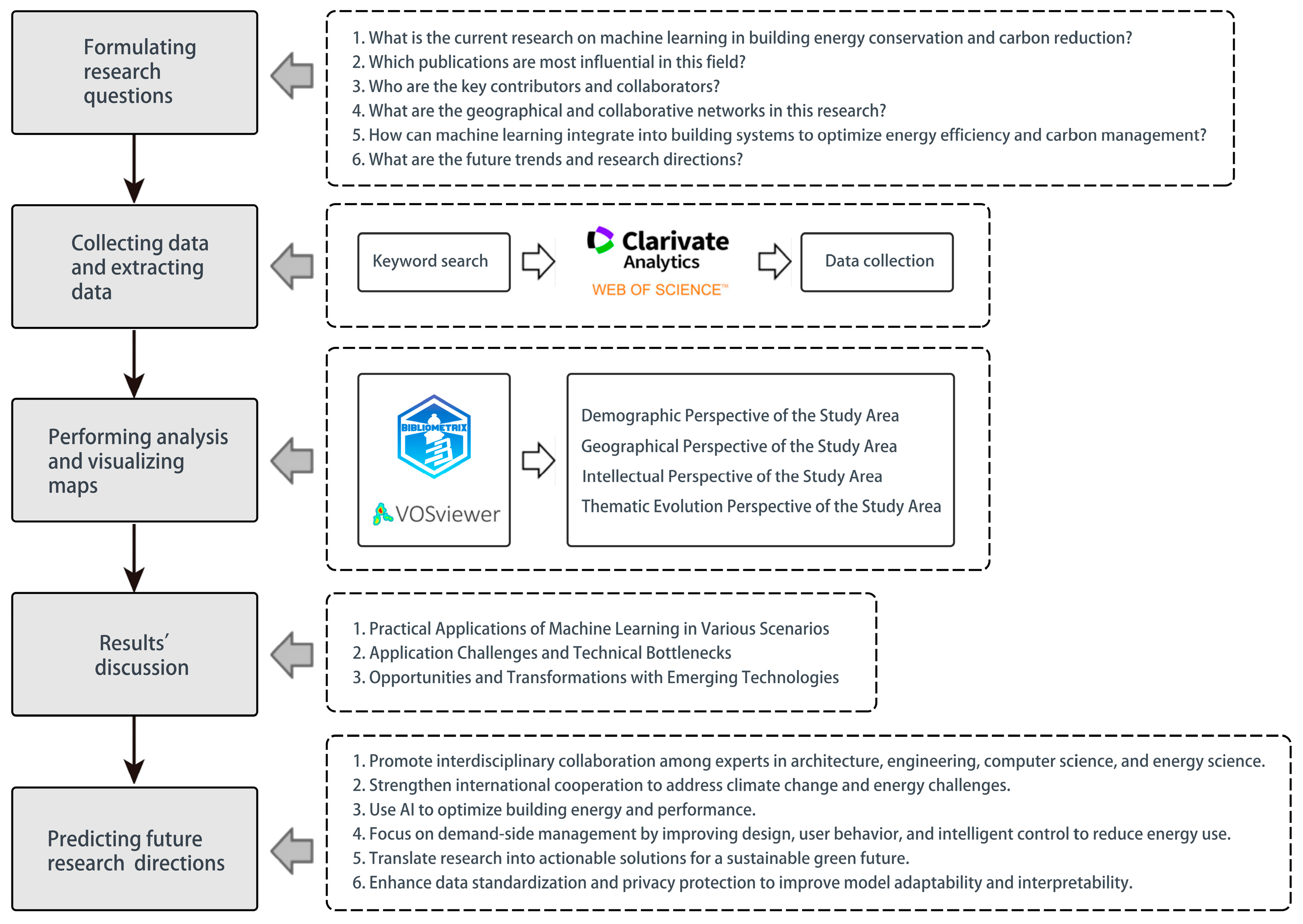
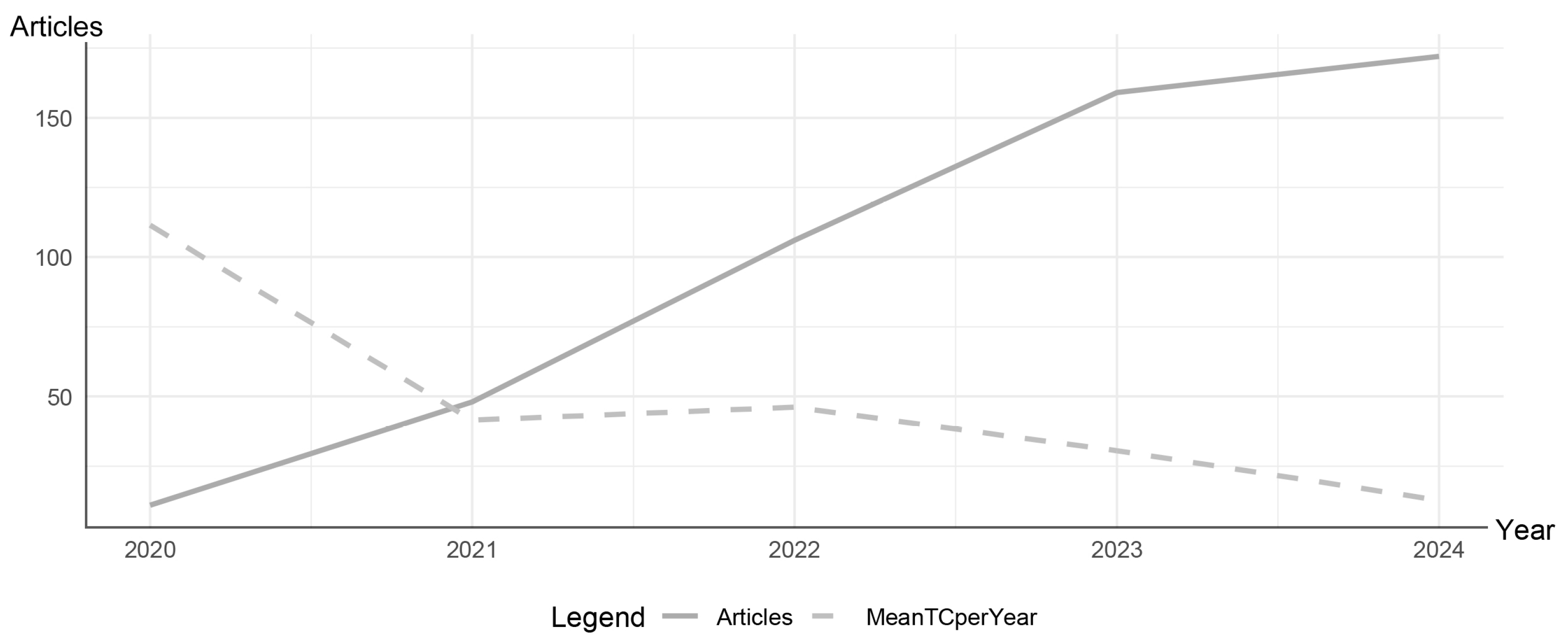
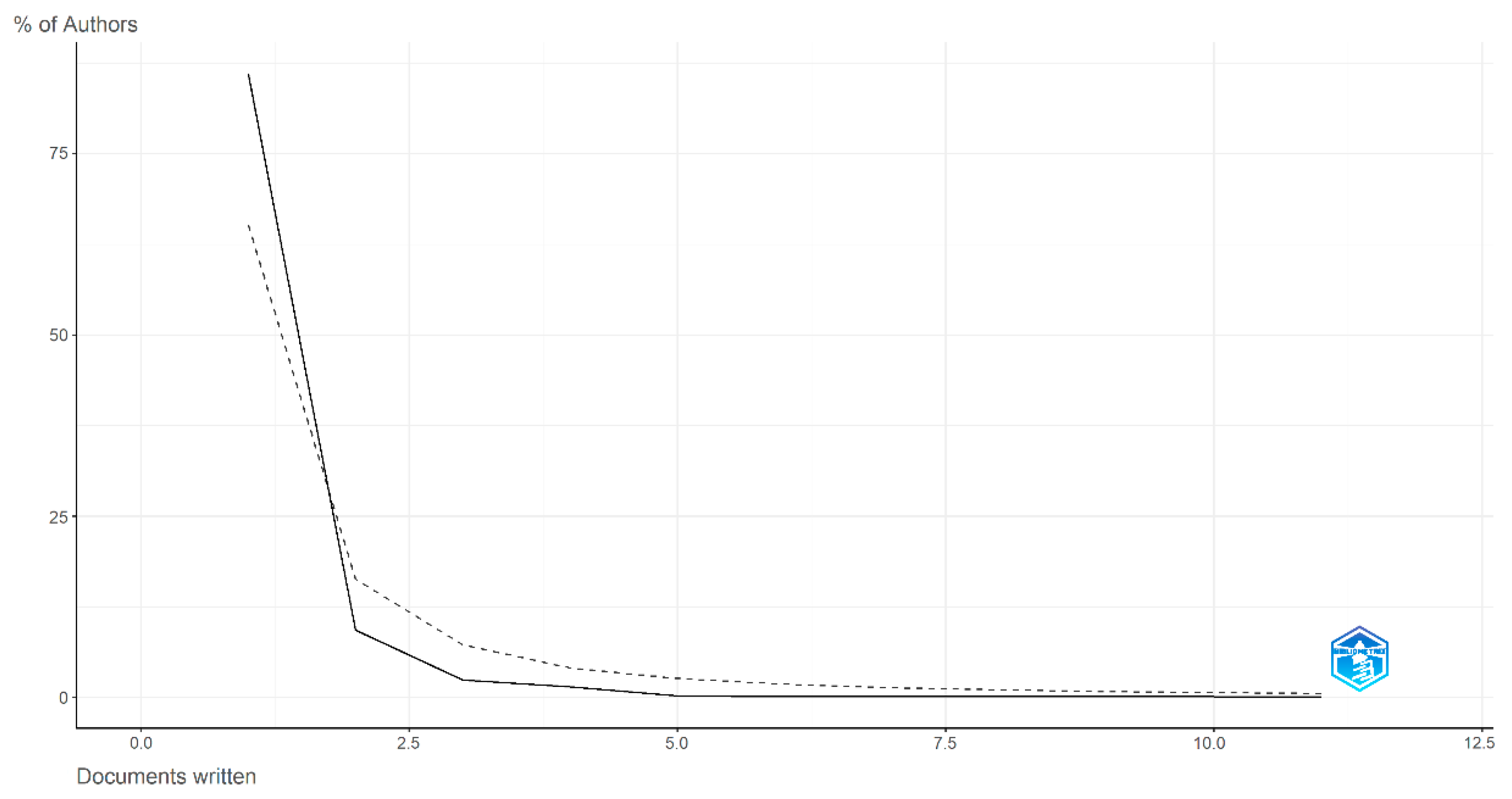

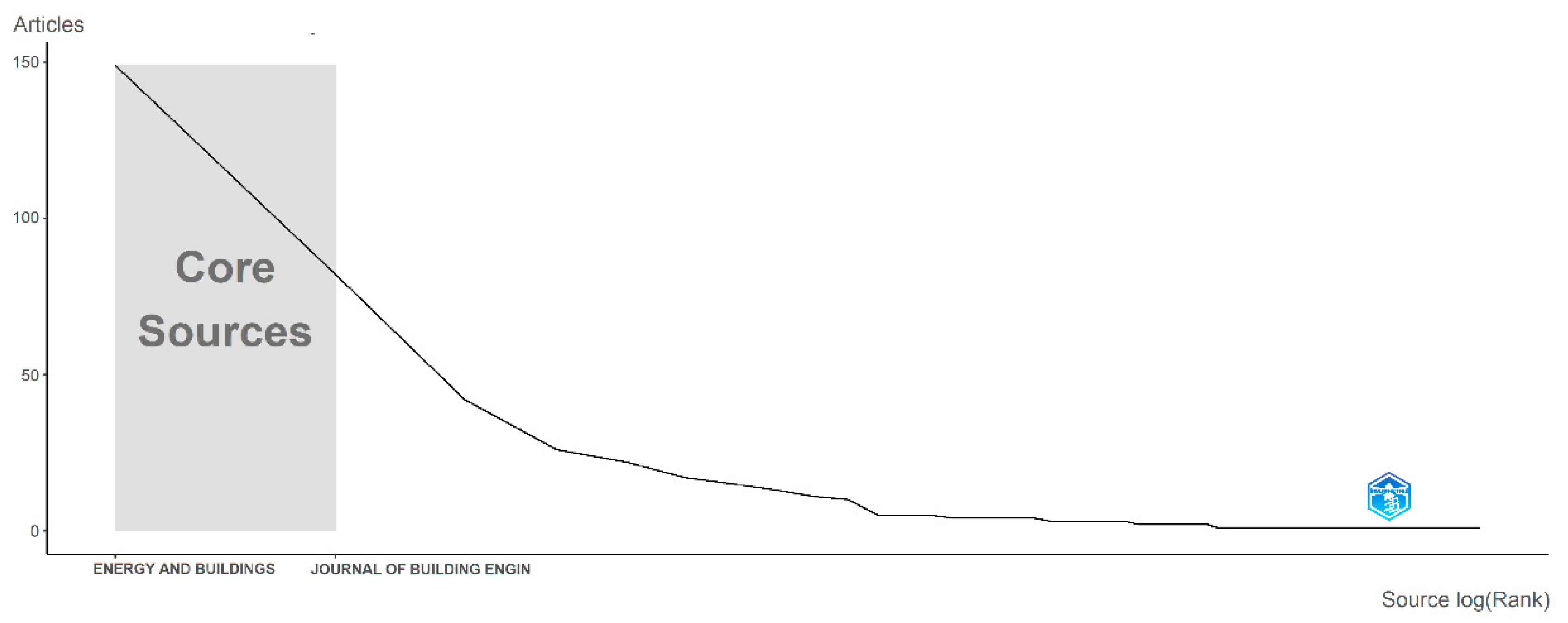
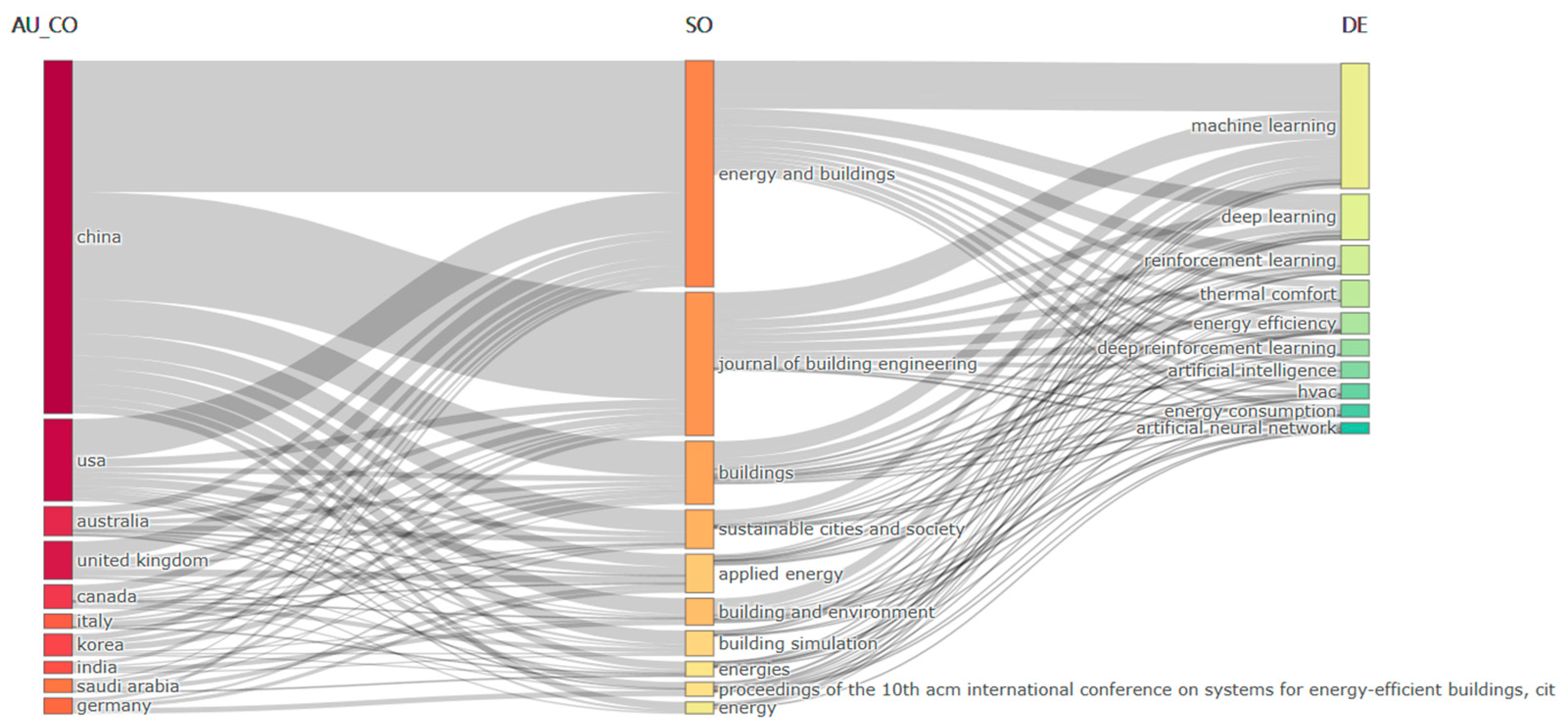

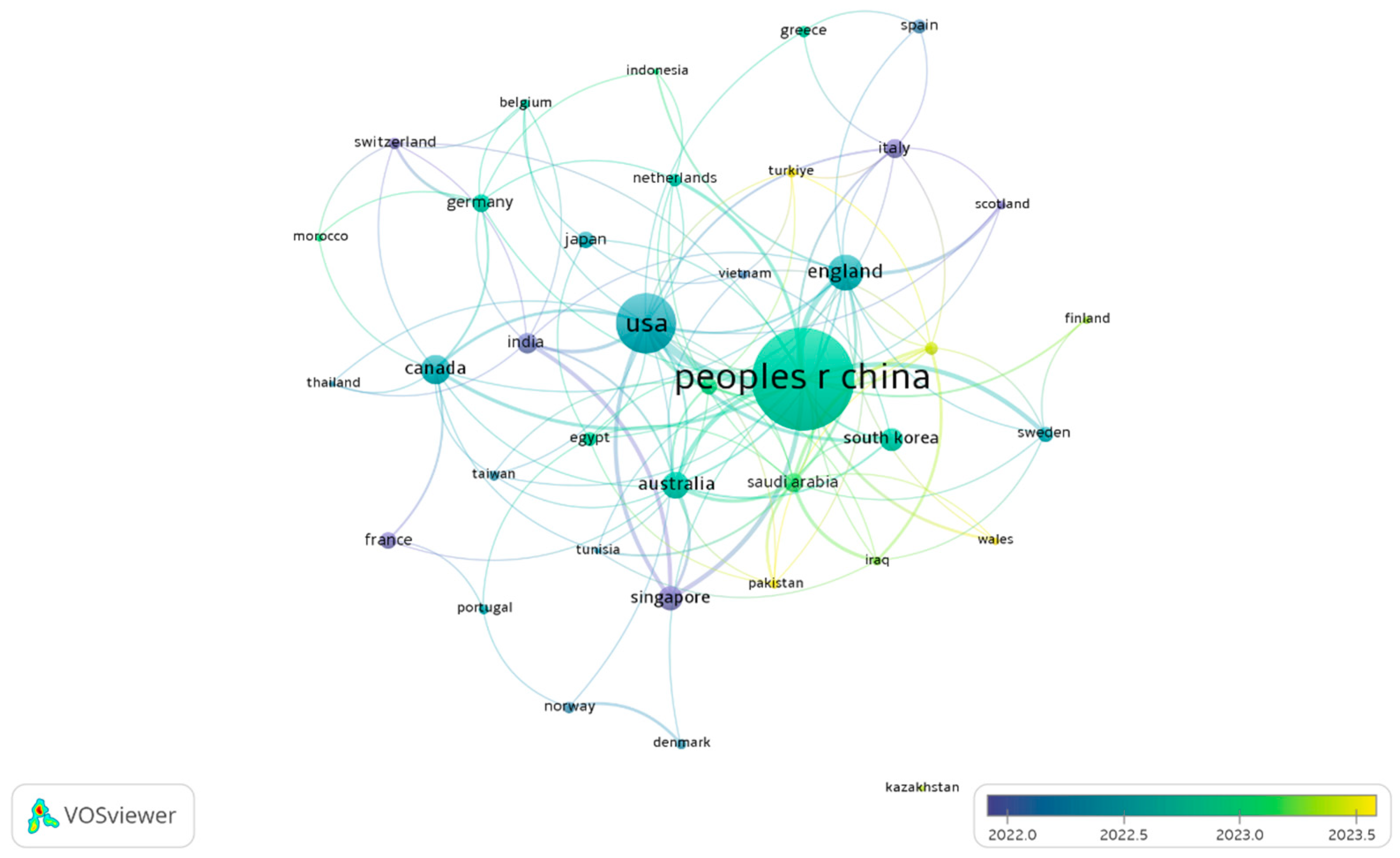

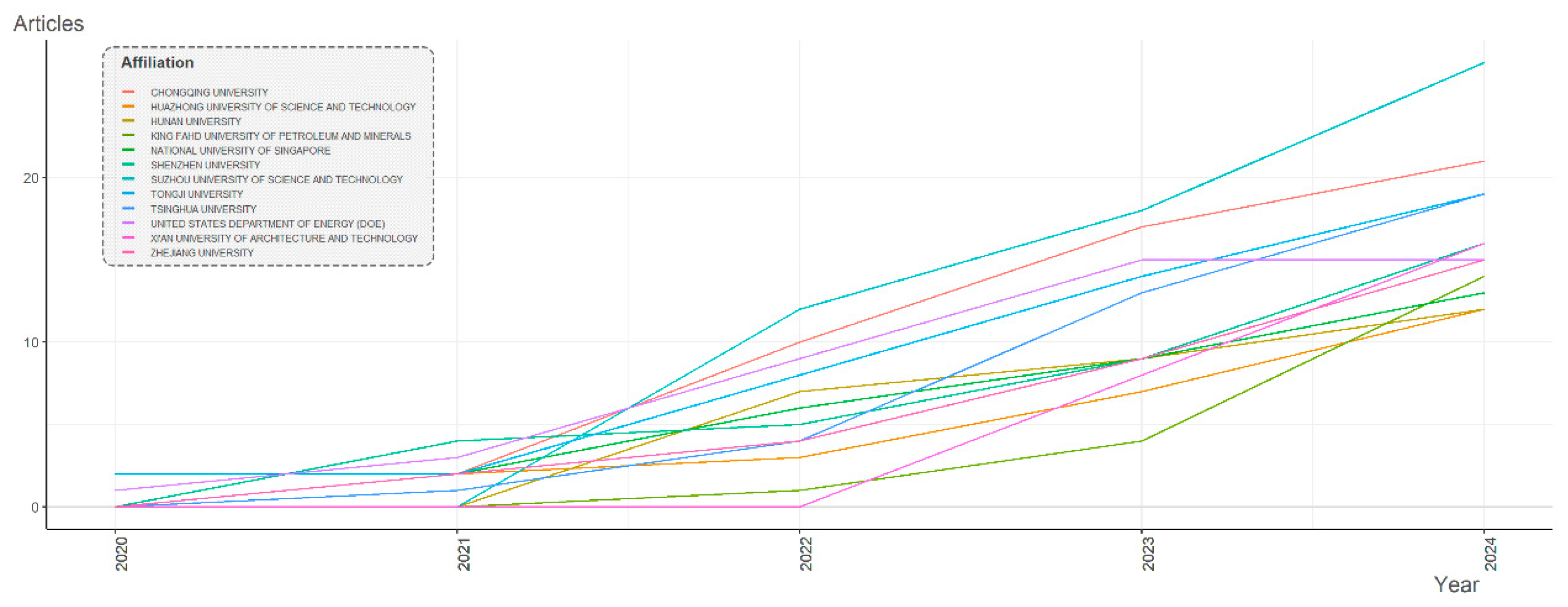
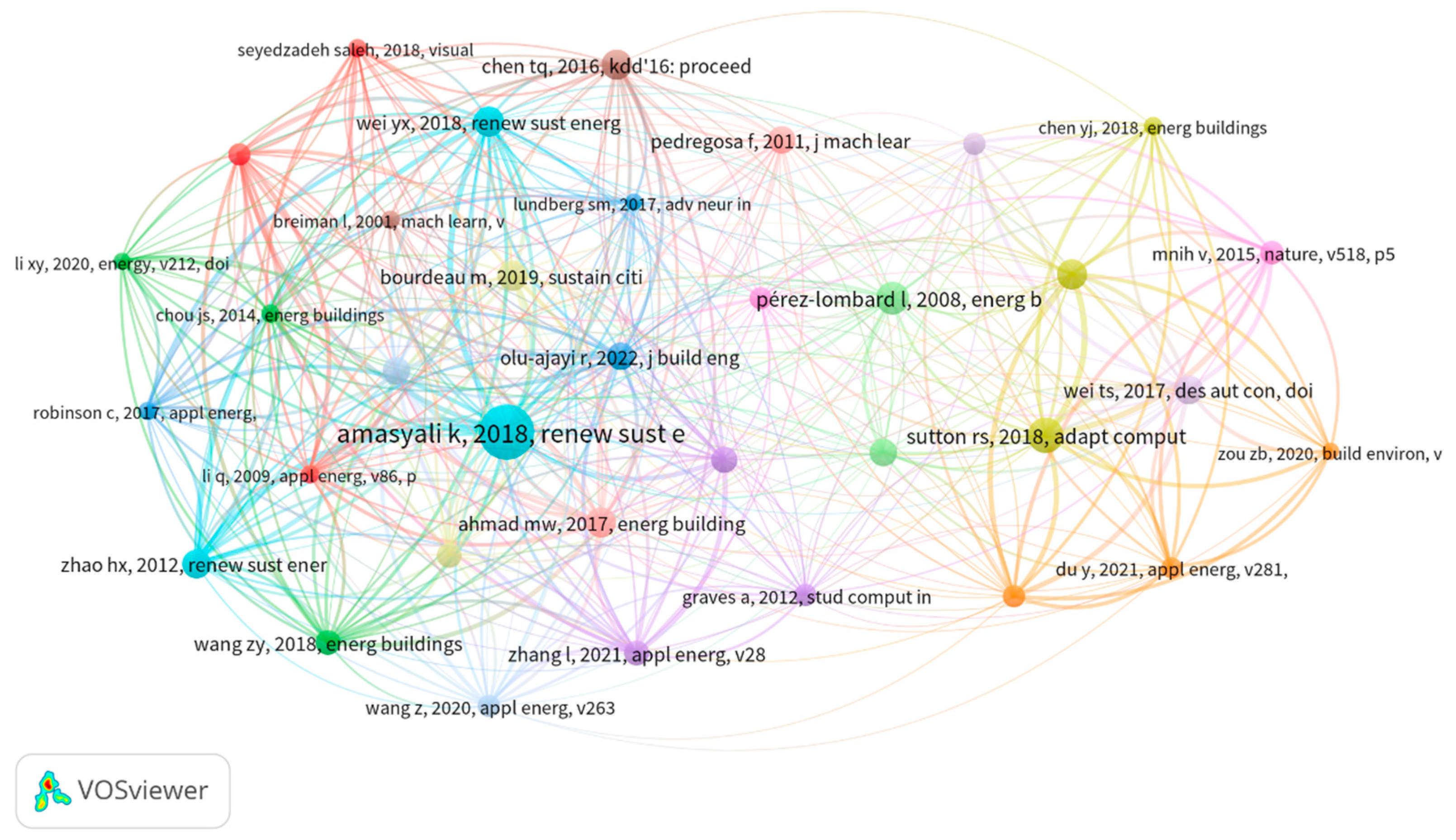
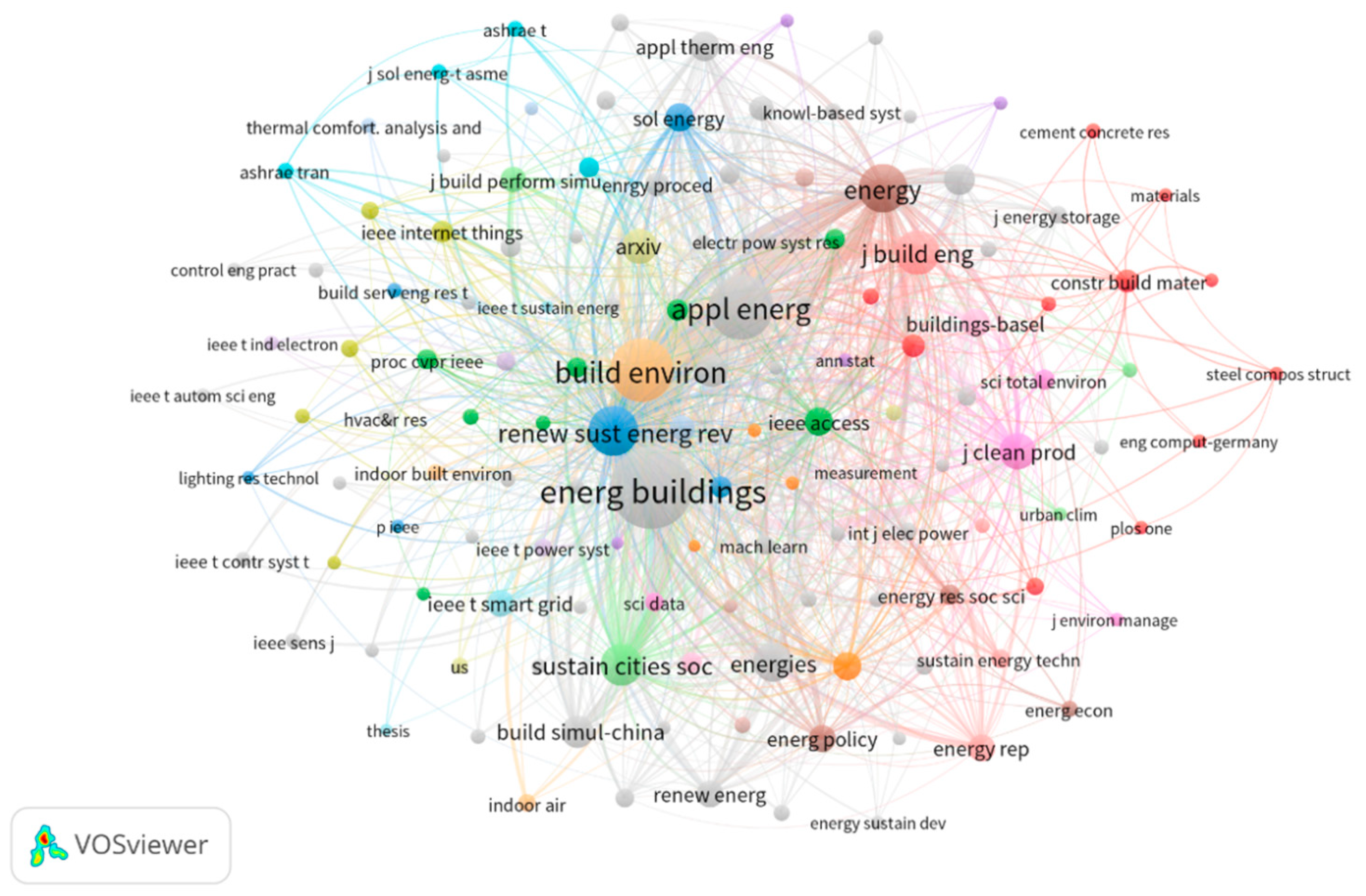




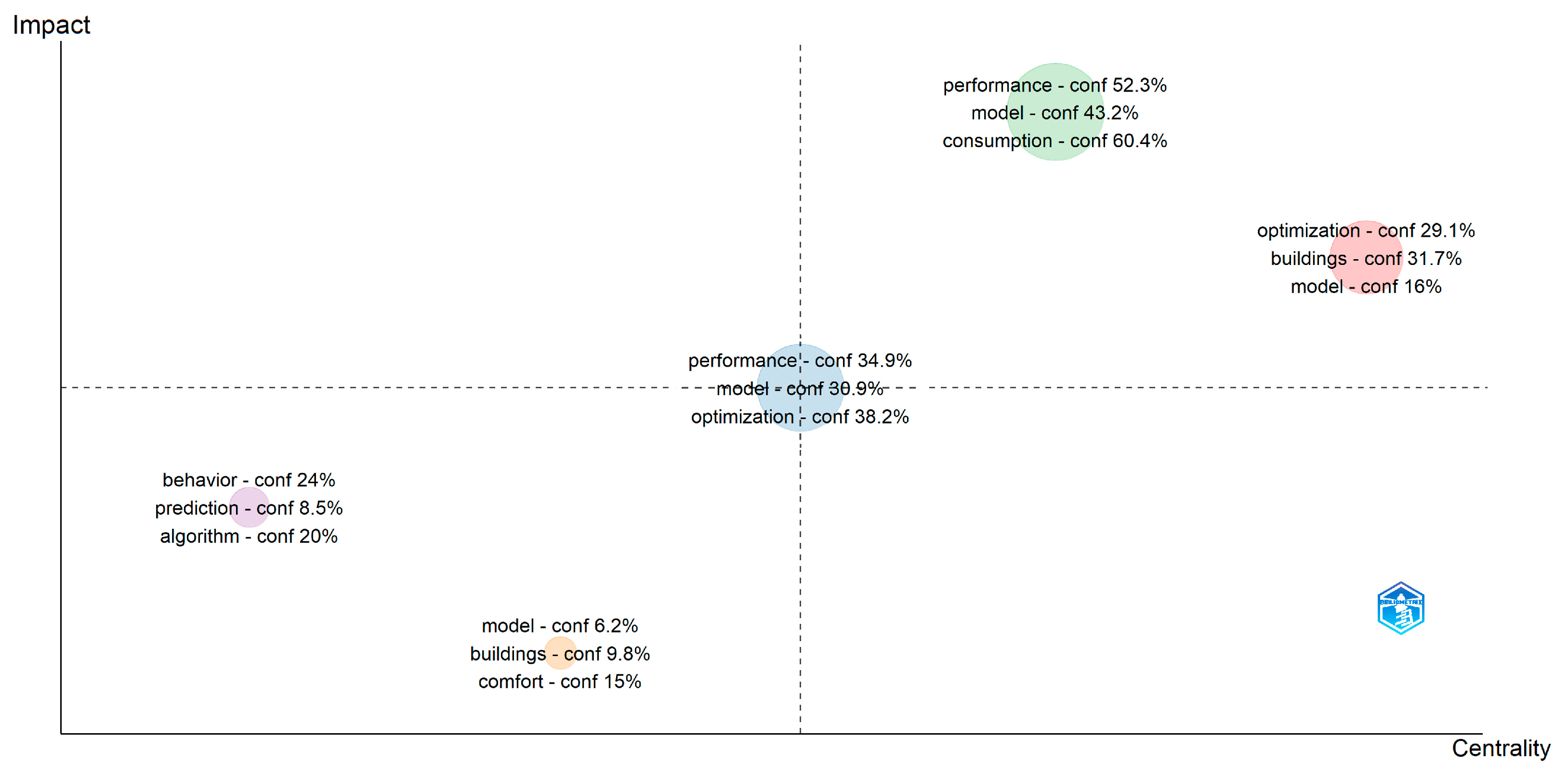
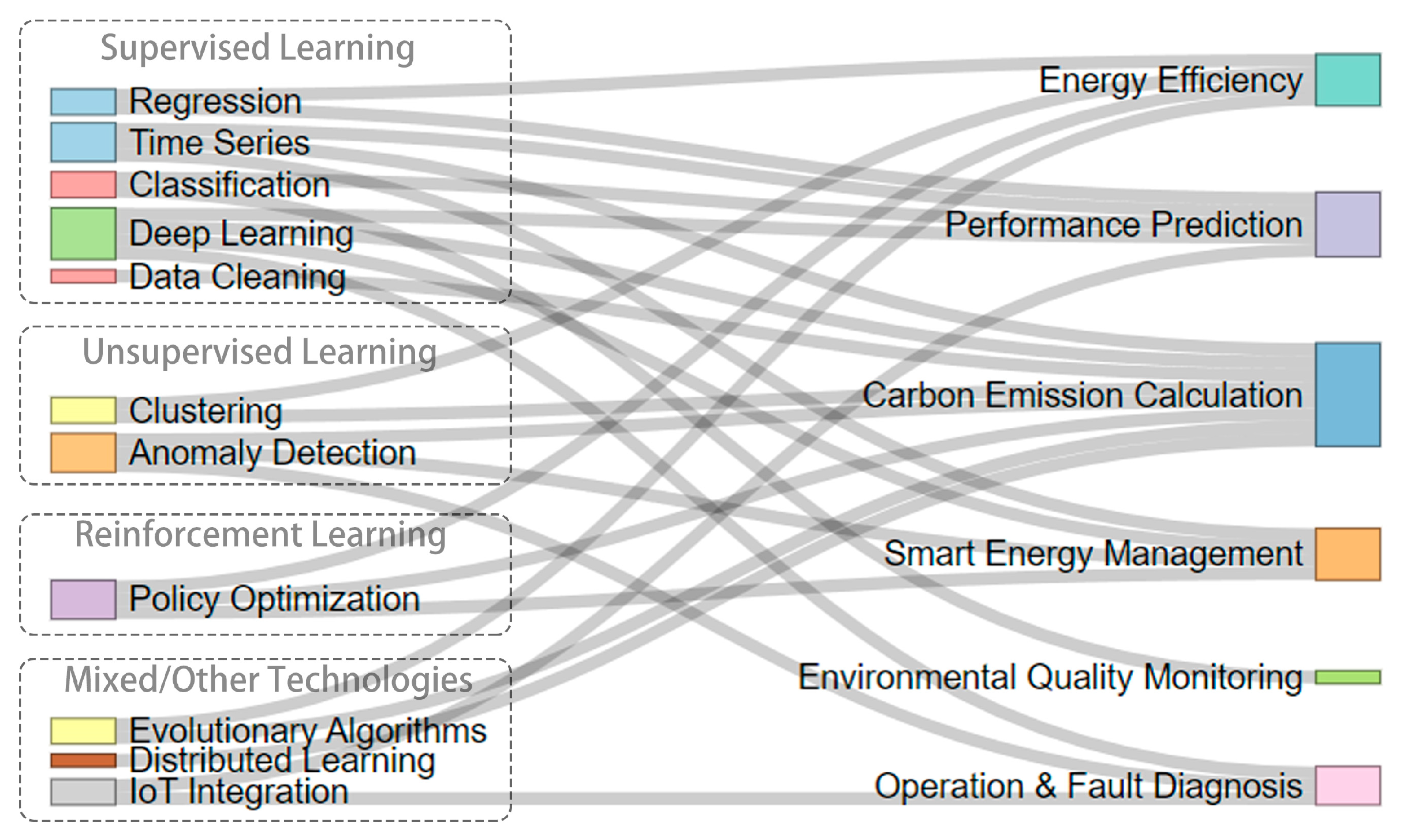
| Topic | Comments | Key Content Summary |
|---|---|---|
| Machine Learning in Building Energy Optimization | Focus on dynamic control (e.g., HVAC, energy systems) and generative design, emphasizing the role of algorithms in real-time decision making (e.g., RL). |
|
| Machine Learning for Comfort and Control in the Built Environment | Coverage of user behavior simulation and environmental parameter prediction, embodying “human-centric” intelligent regulation. |
|
| Machine Learning and Building Design and Modeling | From physical structure optimization to system-level building modeling, combining mature AI with hybrid modeling methods. |
|
| Data-Driven Methods in the Built Environment | Emphasis on data acquisition (e.g., large-scale datasets) and model interpretability, addressing data scarcity and trust issues. |
|
| Description | Results |
|---|---|
| Timespan | 2020–2024 |
| Sources (journals, books, etc.) | 73 |
| Documents | 496 |
| Annual growth rate % 1 | 98.85 |
| Document average age | 1.13 |
| Average citations per documents 2 | 11.26 |
| References | 20,923 |
| Authors | 1781 |
| Authors of single-authored documents | 8 |
| Single-authored docs | 8 |
| Co-Authors per documents 3 | 4.4 |
| International co-authorships % 4 | 27.02 |
| Author | H_Index | G_Index | M_Index | Total Citations | Number of Publications | Publication Year Start |
|---|---|---|---|---|---|---|
| Wu HJ | 6 | 11 | 2 | 143 | 11 | 2022 |
| Calautit JK | 5 | 7 | 1 | 226 | 7 | 2020 |
| Chen JP | 5 | 9 | 1.667 | 151 | 9 | 2022 |
| Fu QM | 5 | 9 | 1.667 | 151 | 9 | 2022 |
| Liu JY | 5 | 7 | 1.25 | 153 | 7 | 2021 |
| Lu Y | 5 | 9 | 1.667 | 112 | 9 | 2022 |
| Wei SY | 5 | 6 | 1 | 134 | 6 | 2020 |
| Amayri M | 4 | 5 | 1.333 | 46 | 5 | 2022 |
| Capozzoli A | 4 | 4 | 0.8 | 184 | 4 | 2020 |
| Fan C | 4 | 4 | 1 | 90 | 4 | 2021 |
| Homod RZ | 4 | 4 | 1.333 | 50 | 4 | 2022 |
| Piscitelli MS | 4 | 4 | 0.8 | 184 | 4 | 2020 |
| Tien PW | 4 | 4 | 1 | 71 | 4 | 2021 |
| Wang YZ | 4 | 5 | 1.333 | 98 | 5 | 2022 |
| Wu YP | 4 | 4 | 1 | 153 | 4 | 2021 |
| Source | H_Index (Local) | G_Index (Local) | M_Index (Local) | Total Citations | Number of Publications (2020–2024) |
|---|---|---|---|---|---|
| Energy and Buildings | 25 | 41 | 5 | 2267 | 149 |
| Journal of Building Engineering | 15 | 29 | 3 | 1049 | 82 |
| Applied Energy | 10 | 17 | 2 | 381 | 17 |
| Building and Environment | 9 | 16 | 2.25 | 275 | 22 |
| Sustainable Cities and Society | 9 | 17 | 1.8 | 315 | 26 |
| Buildings | 8 | 12 | 2 | 196 | 42 |
| Building Simulation | 6 | 13 | 1.5 | 187 | 15 |
| Energy | 5 | 8 | 1.667 | 80 | 10 |
| Energies | 4 | 9 | 1 | 89 | 11 |
| Renewable and Sustainable Energy Reviews | 4 | 4 | 1 | 170 | 4 |
| Building Services Engineering Research and Technology | 3 | 4 | 0.75 | 24 | 5 |
| Frontiers in Built Environment | 3 | 4 | 1 | 36 | 4 |
| Journal of Building Performance Simulation | 3 | 3 | 1 | 28 | 3 |
| No. | Paper | Total Citations | Total Citations per Year | Normalized Total Citations |
|---|---|---|---|---|
| 1 | Olu-Ajayi R, 2022, J Build Eng [48] | 227 | 75.67 | 12.29 |
| 2 | Brandi S, 2020, Energ Buildings [49] | 128 | 25.6 | 1.91 |
| 3 | Xie JQ, 2020, Energ Buildings [50] | 122 | 24.4 | 1.82 |
| 4 | Gopinath R, 2020, Sustain Cities Soc [51] | 115 | 23 | 1.72 |
| 5 | Dong ZX, 2021, Energ Buildings [52] | 111 | 27.75 | 5.35 |
| 6 | Hosamo HH, 2022, Energ Buildings—A [53] | 101 | 33.67 | 5.47 |
| 7 | Seyedzadeh S, 2020, Appl Energ [54] | 99 | 19.8 | 1.48 |
| 8 | Zhang WX, 2022, Renew Sust Energ Rev [20] | 92 | 30.67 | 4.98 |
| 9 | Mounir N, 2023, Energ Buildings [55] | 77 | 38.5 | 8.4 |
| 10 | Fu QM, 2022, J Build Eng [9] | 71 | 23.67 | 3.84 |
| Affiliation | Articles |
|---|---|
| Suzhou University Of Science And Technology | 27 |
| Chongqing University | 21 |
| Tongji University | 19 |
| Tsinghua University | 19 |
| Shenzhen University | 16 |
| Xi’an University Of Architecture And Technology | 16 |
| United States Department Of Energy (Doe) | 15 |
| Zhejiang University | 15 |
| King Fahd University Of Petroleum And Minerals | 14 |
| National University Of Singapore | 13 |
| Words | Occurrences | Dim1 | Dim2 | Cluster |
|---|---|---|---|---|
| performance | 91 | 0.17 | 0.41 | 1 |
| model | 88 | 0.23 | 0.33 | 1 |
| optimization | 56 | −0.54 | −0.44 | 1 |
| simulation | 56 | −0.08 | −0.27 | 1 |
| consumption | 55 | 0.41 | 0.31 | 1 |
| prediction | 50 | 0.44 | −0.23 | 1 |
| buildings | 43 | −0.36 | 0.16 | 1 |
| design | 42 | 0.18 | 0.77 | 1 |
| systems | 42 | −0.14 | −0.28 | 1 |
| energy consumption | 35 | 0.02 | 0.03 | 1 |
| Cluster | Callon Centrality | Callon Density | Rank Centrality | Rank Density | Cluster Frequency |
|---|---|---|---|---|---|
| storage | 0 | 25 | 1.5 | 13 | 4 |
| implementation | 0.083 | 16.667 | 6 | 2.5 | 6 |
| CO2 emissions | 0.16 | 18.571 | 11 | 4 | 12 |
| demand | 1.492 | 23.73 | 13 | 11 | 305 |
| network | 0.088 | 14.286 | 7 | 1 | 7 |
| performance | 5.59 | 19.632 | 14 | 5 | 1165 |
| demand response | 0.125 | 22.917 | 8 | 10 | 10 |
| compressive strength | 0.128 | 16.667 | 9 | 2.5 | 6 |
| energy management | 0.04 | 20 | 3 | 7.5 | 5 |
| challenges | 0.05 | 22 | 4 | 9 | 10 |
| electricity consumption | 0.451 | 19.984 | 12 | 6 | 34 |
| life-cycle assessment | 0.075 | 25 | 5 | 13 | 10 |
| hot | 0 | 25 | 1.5 | 13 | 4 |
| internet | 0.15 | 20 | 10 | 7.5 | 5 |
| Label | Group | Frequency | Centrality | Impact |
|---|---|---|---|---|
| optimization—conf 29.1% buildings—conf 31.7% model—conf 16% | 1 | 83 | 0.26 | 2.238 |
| performance—conf 34.9% model—conf 30.9% optimization—conf 38.2% | 2 | 132 | 0.213 | 2.081 |
| performance—conf 52.3% model—conf 43.2% consumption—conf 60.4% | 3 | 187 | 0.227 | 2.513 |
| behavior—conf 24% prediction—conf 8.5% algorithm—conf 20% | 4 | 27 | 0.152 | 1.682 |
| model—conf 6.2% buildings—conf 9.8% comfort—conf 15% | 5 | 21 | 0.183 | 1.656 |
| Application Scenarios | Role of Machine Learning | Corresponding Techniques | Key Advantages | Typical Cases | References |
|---|---|---|---|---|---|
| Carbon Emission Calculation and Optimization | Data integration | Anomaly detection algorithms, data cleaning algorithms | Enhances data quality and reliability, laying a foundation for carbon emission modeling | Multisource heterogeneous data integration and analysis | [75,76,77] |
| Carbon emission modeling and prediction | Deep learning (e.g., ANN), time series forecasting (LSTM, Transformer), reinforcement learning | Accurately captures the complex relationship between building performance and carbon emissions, improving prediction accuracy | Carbon emission trend prediction | [48,69,78,79] | |
| Optimization of life cycle carbon emission assessment | Reinforcement learning, genetic algorithms | Provides dynamic optimization strategies to balance energy consumption and carbon emissions | Intelligent energy management systems | [80,81,82] | |
| Data privacy and model sharing | Federated learning | Addresses data privacy issues and enhances regional optimization capabilities | Collaborative optimization within industries | [72,73,74] | |
| Energy-Saving Design Methods and Practices | Data-driven analysis | Regression models, clustering algorithms | Extracts key parameters to optimize design elements | Region-specific climate design | [83,84,85,86] |
| Intelligent design assistance | Genetic algorithms, Bayesian optimization, BIM with reinforcement learning | Rapidly explores multi-objective design solutions, balancing energy consumption and comfort | Optimization of building orientation and materials | [87,88,89,90] | |
| Material and structure optimization | Database mining, simulation techniques | Recommends efficient materials, optimizing natural ventilation and shading designs | Natural ventilation path optimization | [91,92,93,94] | |
| Environmental adaptability design | Digital twin technology, future climate analysis models | Simulates building operational states and evaluates energy-saving effects in real time | Digital twin building design | [53,95,96,97] | |
| Intelligent Energy Management Strategies | Energy consumption forecasting | Time series analysis (ARIMA, LSTM) | Accurately predicts building energy consumption to support system scheduling | Adjustment during peak energy demand periods | [98,99,100,101] |
| System operation strategy optimization | Reinforcement learning | Dynamically adjusts HVAC systems to balance energy consumption and comfort | Intelligent air-conditioning systems | [102,103,104] | |
| Anomaly warning and equipment diagnostics | Deep learning, anomaly detection algorithms | Enhances management reliability and extends equipment lifespan | Early warning for air-conditioning equipment | [105,106,107] | |
| Performance Prediction and Environmental Quality Monitoring | Energy efficiency prediction and optimization | Regression analysis, deep learning, ensemble learning | Identifies potential issues in advance and optimizes energy scheduling | Energy consumption optimization management | [52,108] |
| Real-time indoor environmental quality monitoring and control | Deep learning, sensor networks | Dynamically adjusts air-conditioning and lighting systems to ensure optimal environmental conditions | Indoor thermal comfort control | [109,110,111] | |
| Operations and Fault Diagnosis | Fault prediction and maintenance | Anomaly detection, deep learning | Predicts equipment failures and reduces downtime | Optimized maintenance of lighting systems | [112,113] |
| Real-time monitoring and remote management | IoT combined with deep learning | Enhances operational efficiency and management flexibility | Intelligent building equipment management | [114,115] |
| Category | Specific Challenges | Cause Analysis | Strategies |
|---|---|---|---|
| Data Level | High heterogeneity of data sources, complex integration | Data come in various forms (e.g., energy consumption monitoring, weather data, BIM), with differing formats, sampling frequencies, and accuracies, lacking standardization [80] | Standardize data collection and cleaning processes and develop unified data processing tools |
| Severe issues with missing, inconsistent, and noisy data | Variations in collection device performance, environmental interference, or human errors lead to low data quality, affecting model training [116] | Employ anomaly detection and data cleaning techniques, such as missing value imputation and noise filtering, to enhance data reliability | |
| Data scarcity and imbalance | In specific scenarios (e.g., fault diagnosis), normal data dominate, while minority class samples are insufficient, impairing the model’s ability to recognize minority categories | Use data augmentation techniques (e.g., synthetic data generation), clustering analysis, and transfer learning to mitigate imbalance issues | |
| Data privacy and security constraints | Data involving user behavior or corporate information cannot be directly shared, increasing collaboration difficulties [117,118,119] | Introduce federated learning to enable localized training and collaborative optimization while protecting privacy | |
| Model Level | “Black-box” nature of models reduces trust | Complex models like deep learning lack transparency, making their decision-making logic difficult to interpret [18] | Adopt explainable AI (XAI) techniques, integrating feature importance analysis and visualization tools to enhance transparency |
| Insufficient generalization ability | Diverse building scenarios and limited training data lead to poor model performance in new environments [76] | Enhance data diversity (e.g., cross-regional data fusion) and optimize model architectures to improve adaptability | |
| Lack of real-time updating capability | Building system operations are dynamic, and traditional models cannot quickly adapt to new data | Develop online learning methods to support real-time model updates and continuous optimization | |
| Application Complexity | Multi-objective optimization increases design complexity | Scenarios (e.g., energy-saving design, energy management) require balancing multiple objectives, such as energy consumption, comfort, and cost, adding to the complexity of model design and optimization [120,121,122] | Employ reinforcement learning and multi-objective optimization algorithms, combined with intelligent search strategies, to quickly explore optimal design and operational parameters |
| Cross-regional standard differences | Significant differences in carbon emission calculations and building design standards across regions make direct model application challenging [123,124] | Implement modular model design and parameter tuning to adapt to regional standards | |
| Implementation and Deployment | High technical threshold | Machine learning requires interdisciplinary knowledge in mathematics, computer science, and architecture, but relevant professionals often lack such backgrounds | Conduct interdisciplinary training and develop user-friendly tools and platforms |
| High development and deployment costs | Projects require highly customized development, with tools and platforms lacking standardization, leading to high resource consumption [125,126] | Develop standardized and modular machine learning frameworks and platforms to reduce redundant development costs | |
| Lack of robust data-sharing mechanisms | Data silos between building projects hinder collaboration and limit the use of cross-project data resources [127,128] | Establish trusted data-sharing mechanisms, leveraging blockchain technology to ensure secure data exchange |
Disclaimer/Publisher’s Note: The statements, opinions and data contained in all publications are solely those of the individual author(s) and contributor(s) and not of MDPI and/or the editor(s). MDPI and/or the editor(s) disclaim responsibility for any injury to people or property resulting from any ideas, methods, instructions or products referred to in the content. |
© 2025 by the authors. Licensee MDPI, Basel, Switzerland. This article is an open access article distributed under the terms and conditions of the Creative Commons Attribution (CC BY) license (https://creativecommons.org/licenses/by/4.0/).
Share and Cite
Liu, J.; Chen, J. Applications and Trends of Machine Learning in Building Energy Optimization: A Bibliometric Analysis. Buildings 2025, 15, 994. https://doi.org/10.3390/buildings15070994
Liu J, Chen J. Applications and Trends of Machine Learning in Building Energy Optimization: A Bibliometric Analysis. Buildings. 2025; 15(7):994. https://doi.org/10.3390/buildings15070994
Chicago/Turabian StyleLiu, Jingyi, and Jianfei Chen. 2025. "Applications and Trends of Machine Learning in Building Energy Optimization: A Bibliometric Analysis" Buildings 15, no. 7: 994. https://doi.org/10.3390/buildings15070994
APA StyleLiu, J., & Chen, J. (2025). Applications and Trends of Machine Learning in Building Energy Optimization: A Bibliometric Analysis. Buildings, 15(7), 994. https://doi.org/10.3390/buildings15070994





